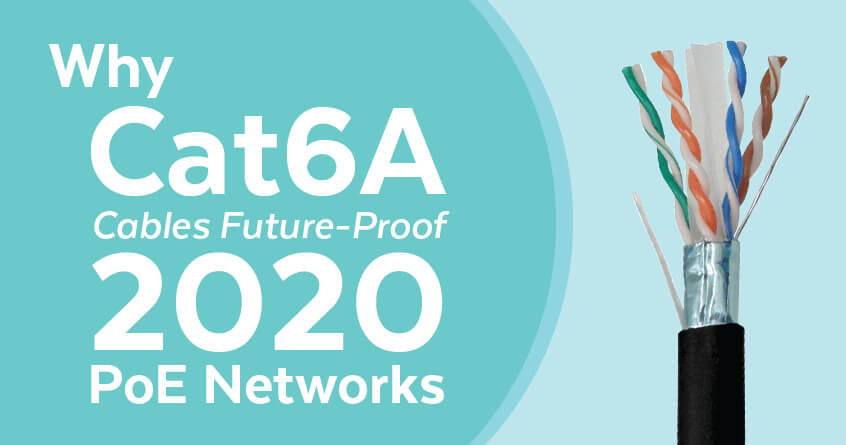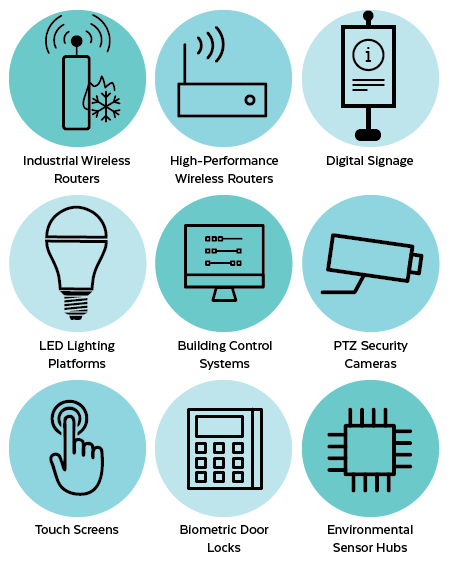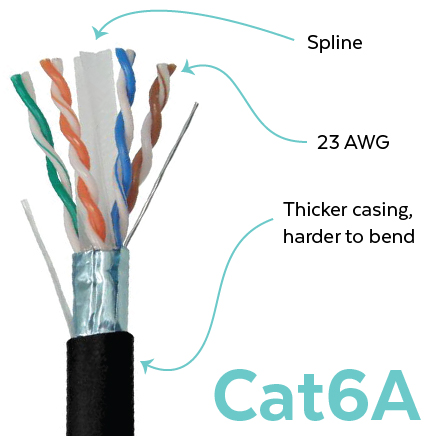Cat6A Cables: Powering IoT Devices of the Future
More and more IoT devices are coming online, and end-users are opting to go with Ethernet because of the convenience and money-saving capabilities of power and data transmission over a single cable. As the Internet of Things (IoT) continues to develop, these devices are becoming more customizable, programmable, and requiring more and more power to run. When a power-hungry device is attached to a legacy cable, the signal can deteriorate over time due to excessive amounts of heat, and insertion loss affects the performance levels of the Powered Device (PD) diminishing efficiency.
Right now, Power over Ethernet (PoE) is moving into the 100W power delivery stage. That is why Cat6A Ethernet Cables are becoming increasingly popular. It makes sense to have the right cable for many of these newer technologies.
A list of some of the devices Cat6A supports.
This blog will take a closer look at some of the Cat6A Ethernet cable features and why its feature set will take us through the next few technology refreshes.
Cat6A Designed For Higher Performance
Cat6A can comfortably handle up to 10-Gigabit networking over the entire 328-foot length. This robust option provides plenty of headroom for IT networks these days with 100 percent uptime. Why is Cat6A sturdier? That capability is due to several components.
- Cat6A has a spline or layer between twisted pair cables. This shield prevents interference from internal “bleed” from the other twisted pair and external interference due to electromagnetic interference from machinery, m
icrowaves, and power lines in the vicinity.
- Like Cat 6, Cat6A twisted pairs have a cable gauge of 23 AWG. In contrast, Cat6A is more tightly wound than Cat6, providing more copper per inch. This higher density of copper is one reason why this grade of cabling costs more. That same thickness also provides a more robust signal path and thus reduces resistance and prevents power loss.
- Cat6A (a full 328-feet) signals reach farther than Cat6 (110-feet). Outside of a local area network (LAN) deployment, it gives installers more flexibility and real estate for connecting devices throughout a structure and between buildings.
- Cat6A has thicker casings, making it more durable in extreme weather conditions and improving the signal-to-noise ratio (SNR). Outdoor rated can easily handle rain, underground and extreme temperature environments.
- Cat6A is stiff and harder to bend, making it a bit more challenging to install, but the benefits in terms of network expansion and smart building deployments make it an ideal choice.
Those are features specific to Cat6A grade cables. There are other features universal to all Ethernet cables that are worth noting.
Other Cat6A Features
Any cable used for indoor installation must comply with National Fire Protection Association (NFPA) safety standards. These are available at two levels: plenum-rated and riser-rated.
Fire Safety
Plenum cable installs in the plenum spaces of a building and provides a fire safety protection level that resists burning or even igniting. Plenum cable complies with NFPA 90A and must consist of fire-retardant jackets.
The plenum part of a building consists of things like heating and cooling systems. Air circulation is a big part of that system. Cables installed in those pathways — such as a dropped ceiling or raised floor–must offer flame resistance.
Riser cable runs between floors through cable risers or elevator shafts within non-plenum areas. Fire resistance levels are not as strict as those for the plenum-rated version. Cables must self extinguish and prevent flames from traveling up the inside of walls.
Outdoor And Remote Installations
Outdoor cable is not flame retardant and, therefore, not designed for inside use. There is an allowable transition threshold, but the outdoor cable is not designed for fire protection inside structures.
Outdoor cable is weather resistant. It can handle rain, burial under the soil, and temperature extremes. Thicker shielding found in Cat6A resists signal interference from external sources such as powerlines.
Cat6A Ethernet Is Application Ready For The 2020 Network
Cat6A facilitates moving the higher levels of data required for smart technologies without heating your cable and resulting in downtime. Cat6A reduces DC resistance and power loss while maintaining performance.
Cat6A cables are ideal for mixed networks that pair long haul transitions over fiber optic cable and then using an SFP Module or Media Converter to link the last mile to Ethernet solutions.
Other Ways Cat6A Cabling Excels
Cat6A doubles the cable’s operating frequency from 250 MHz to 500 MHz and supports bandwidth on the order of 10X higher (10 Gigabit) than regular Cat6 out to 100 meters. It’s going to play a vital role in cabling infrastructure for leading-edge structures going forward. The crisis created by the COVID shutdown has also unleashed a gigantic wave of commercial building construction to adapt the workspace to providing more private workspace and socially distanced collaboration areas.
Conclusion
Though slightly costlier on the front end, Cat 6a supports the technology demands in the Smart Building space. While both Cat5e and Cat6 continue to support networks in residential and small business settings, the horizon line is shifting, and more significant data and power thresholds will meet the requirements of 100BASE, 200BASE and 400BASE Ethernet. There’s currently talk of a possible 800BASE standard and also of single cable Ethernet to be implemented on the floor of manufacturing plants.
Two-way signal paths and more bandwidth are also essential to providing enough speed to IoT end-users and devices. Cat6A will continue to be the best cable solution into the near future.
- Current bandwidth requirements are inching upward from 100GBASE to 200GBASE and 400GBASE.
- With IEEE 802.3bt, 90W power requirements will also become higher.
- The demand for data will drive the need for higher bit rates.
- In a post COVID world, many commercial spaces will need reconfiguring and cabling installations while the return to work process is in full swing makes sense.
If you are interested in Type 4 Ethernet and would like help piecing together your network, feel free to contact us. Our team of IT experts is always happy to assist you.




Join the Discussion 2 Comment